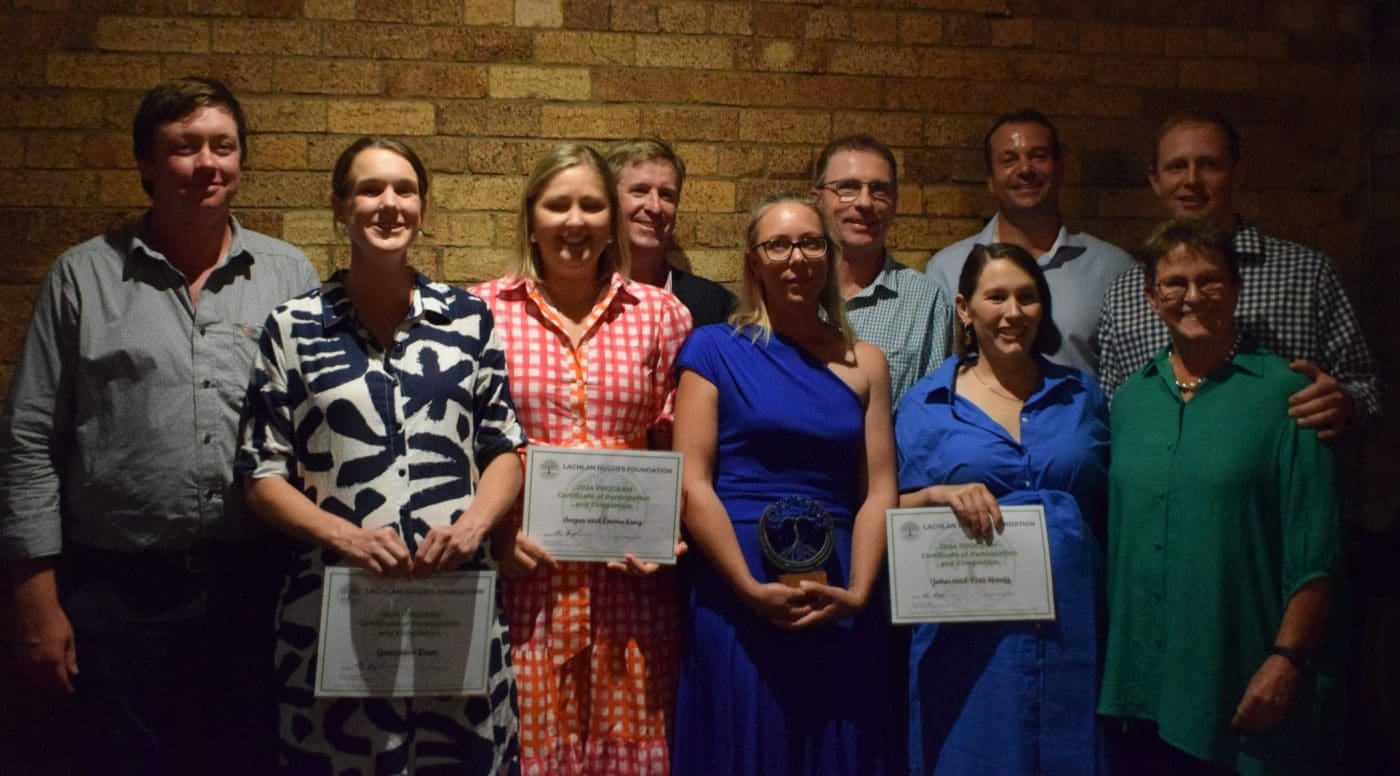
Lauren Beresford holding her Tree of Life trophy in the middle of the group of scholars taking part in last year’s Lachlan Hughes Foundation scholarship. The group met in Toowoomba this week to present the results of their year in the program.
USING cattle to restore life on a hard and compacted claypan in the mulga lands of Western Queensland was the focus of a project that was crowned the winner of last night’s Lachlan Hughes Foundation “Tree of Life” award.
Lauren Beresford from Farnham Plains station, near Eulo, was one of six scholars taking part in last year’s LHF program.
The scholars pick a project to do on their farms, which they implement alongside four workshops that are two-and-a-half days each. The workshops are set up to help learn regenerative practices and develop the skills to share their knowledge among their communities.
- Read about the group of scholars here
Each scholar then presents their project at an event in Toowoomba to their peers and a panel of judges the next year, who vote for the winner of the Tree of Life award – which gives them access to more training and development. The event was held in Toowoomba this week.
Value adding the yearly weaning process
Mr Beresford’s project was about value-adding the annual weaning process to restore a claypan on the property.
Instead of housing the weaners in the cattle yards overnight, she decided to build temporary breaks on a claypan nearby where the weaners would camp overnight, breaking up the soil and adding nutrients through manure.
“I also put in contour banks to add hydration, the idea was to just add nutrients and try kickstart the system again without using too many external inputs,” she said.
“Because of our isolation, getting inputs can be quite difficult. So, I wanted to use what we already had and for me I chose to use animal impacts.”
Kickstarting conversations about regenerative agriculture and general land management is another focus of the LHF program. It develops a strong community among the scholars and gives them the skills to influence their own communities.
Ms Beresford said her project was specifically done to demonstrate the potential to other producers in the area – in a way she felt was easily replicated.
“The loss of topsoil is quite a big issue in our region, because we have a lot of hard, impermeable, ‘ground’, you wouldn’t even say soil,” she said.
“A lot of people out there see a claypan and think it’s part of the natural environment and don’t really consider that maybe there’s some things that they can do to help that.
“Part of the design of my project was to make regenerating those claypans simple and cost-effective.”
Asked about the results of her project, Ms Beresford said they had surpassed her expectations with the help of some good rain last year.
“I have only done a small section of the claypan at the moment, but I have seen plants come up where I have never ever seen plants come up before,” she said.
“We only had a 12-month window to do the project, but it’s certainly not finished for me. Now that I’ve seen it be successful I’m going to keep going this year. Once it area is done, we can move onto the next.”
Ms Beresford said it was too early to say the impact the project will have on production.
“I think it’s going to be some time before it’s actually a productive site in terms of animal rising and production,” she said.
“I think the key is to help nature along a little bit and then once you have things going in the right direction, lock it up and let it go through the natural process.”
-
The class of 2025 was also announced in Toowoomba this week with Susie Marro, Tim Lee, Ashleigh Rimmington, Trevor Rimmington, Toby Gilmour, Helen Gilmour, Martha Lindstad, Julie Melhop and Dave Madden receiving scholarships.
About the Lachlan Hughes Foundation
The Lachlan Hughes Foundation was started in 2019 to honour the life Dulacca cattle producer Lachlan Hughes, who tragically died at 36-years-old in an on-farm accident the year before. The foundation was started to carry on his passion for regenerative agriculture and restoring soils. His parents Phillip and Adele, along with his wife Anna and their children and younger brother Alister and his wife Jules are actively in running the program.
